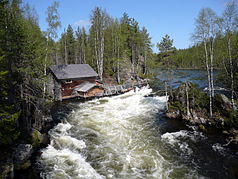Oulanka National Park
| Oulanka National Park | ||
|---|---|---|
|
|
||
| Location: | Northern Ostrobothnia , Finland | |
| Surface: | 290 km² | |
| Founding: | 1956 | |
| View from the trail of the bear trail to the Oulankajoki | ||
The Oulanka National Park is a national park in the taiga of Kuusamo in northeastern Finland .
geography
The river Oulankajoki - with its tributaries Savinajoki and Aventojoki the main attraction of the landscape - flows through the park in a west-east direction. In places these rivers wind their way slowly through the park in many meanders or they form gorge-like valleys with rapids and waterfalls. The Oulankajoki has its headwaters in the municipality of Salla, in north-eastern Finland. It has a total length of 135 km.
Another river that shapes the landscape is the Kitkajoki . He and the Kuusinkijoki are the two largest tributaries of the Oulankajoki. The Kitkajoki flows into the Oulankajoki near the Russian border; the Kuusinkijoki flows into it on the other side of the border, a few kilometers before the river flows into Lake Paanajärvi.
The Paanajärvi is a deep (up to 128 m) elongated (24 km) and narrow (1–1.5 km) fjord-like lake, which can also be viewed as an extension of the Oulankajoki.
In the east, the park borders directly on Russia with the Paanajärvi National Park . Both together are considered Europe's largest cross-border protected area with Russia.
history
As early as 1897 there were plans to propose the area for a national park because of its beauty and special flora. In 1917 the first excursion to the area took place, financed by Karl Fazer , and further scientific excursions were carried out by the botanist Kaarlo Linkola in the 1920s. However, due to unclear ownership and the outbreak of World War II, the national park was only founded in 1956 and expanded in 1982 and 1989. Today it covers 290 km².
129.24 km² in the core zone of the national park belong to the wilderness areas certified by the European Wilderness Society . 16 km of the Kitkajoki and 26 km of the Oulankajoki are also certified as WILDRiver .
nature
In the national park one can find a flora that is very species-rich for the boreal zone , because here - due to the alternation of calcareous and silicate-containing rocks, the terrain profile and the climatic conditions - the distribution areas of species overlap, the focus of which is further north, west, south or Lie east. The majority of the park is made up of light pine and heather forest, interspersed with areas of denser spruce forests and numerous moors . Particularly noteworthy are orchids, such as the yellow lady's slipper and the pink norn , also called venus slipper or fairy slipper , which appears as a flagship species in the national park's emblem.
In addition to the semi-wild reindeer, the common large mammal species in the park include the Sami elk , brown bear , raccoon dog , badger and otter . The occurrence of lynx and wolf is rarer . A total of 30 species of mammals, over 120 species of birds and over 7000 species of insects live here. Among the observable in the park bird species include Siberian jay , redpoll , Siberian tit and crested tit , Brambling , Gimpel , three-toed woodpecker , Waldammer , swifts (in the canyons), capercaillie , hazel grouse and Waxwing . In the area of the Savinajoki lies an important breeding area for whooper swans . On the small lakes live throated diver , velvet and common scoters and Smew . There are some ornithological peculiarities in the moors, such as the miniature snipe , swamp sandpiper and the Odin's grouse . The rarest rarities in the park are the blue-tailed bunting and the dwarf bunting .
leisure
Oulanka is one of the most popular and most visited national parks in Finland. The Oulankajoki invites you to go canoeing and rafting trips lasting several days . Most of those interested come to the visitor center in the valley of Oulankajoki, many hikers go on one-day or several-day hikes on the trail of the bear trail . There are two information points - the Oulanka Visitors Center near the rapids of the Oulankajoki in the center of the park and the Karhunkierros Visitor Center with information boards, information about the plants and animals in the park (Karhu is the Finnish word for the brown bear). In addition to the bear trail, there are numerous shorter trails. They are all marked with colored dots and also have their own symbols. The bear trail, for example, is marked by metal signs in which the bear silhuette is cut out. The trails have their own charm when you cross over with a cable boat, as on the Keroharju Hiking Trail, or through suspension bridges and views of the canyons.
Web links
- Official website of the Finnish Forest Service (English)
- World Database on Protected Areas - Oulanka National Park (English)
- Information for hikers about the area and nature and details about the little bear tour
Individual evidence
- ↑ a b c Angelika Lang, Sven Halling u. Detlef Singer: Nature guide: Northern Scandinavia with Finland. BLV, Munich / Vienna / Zurich 1994, ISBN 3-405-14512-0 , pp. 169-175.
- ↑ Klement Tockner , Urs Uehlinger, Christopher T. Robinson: Rivers of Europe . Academic Press, London 2009, ISBN 978-0-08-091908-9 , chap. 8th.
- ^ Bernard Stonehouse and John M. Snyder: Polartourism - an environmental perspective . Channel View Publications, Bristol 2010, ISBN 978-1-84541-146-6 , p. 39.
- ↑ European Wilderness Network: Finland , accessed March 6, 2019.



